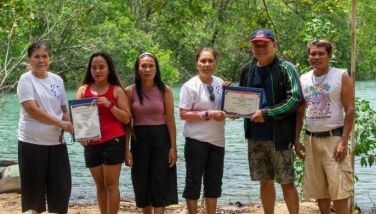No such thing as race
Beauty is the only accident that we would love to have and regret to miss. Grateful as we are for our parents’ role in our being alive, the color of your skin, the shape of your nose, the stretch of your ears, or the slant of your eyes are not the products of their deliberated plan. In fact, if you came to be in this world like I did, your parents must have conceived you, as Bill Cosby said, with the same frame of mind that Napoleon had at the time they invaded Russia: it just seemed like a good idea at that time. Our parents did not go to the biological equivalent of a craft shop in Divisoria to choose each of our parts to put us together. However we turned out, whether we believe billboards and glossy magazines of their idea of beauty or if we subscribe to any religious treatise that we are here for a reason, as far as biology is concerned, how you look or how you are put together is an accident.
If you think that being an accident makes you feel empty, get over it and think again. And if you have cable, you may get a big boost. The National Geographic Channel adds another episode to get us into the habit of making us think again and again. This time, it is The Human Family Tree of the National Genographic Project sponsored by the National Geographic, IBM and the Waitt Family Foundation, to premier in Asia on Sept. 26 at 9 p.m.
The project started in 2005 and their first program on the project called The Human Journey presented how science, thru genetics, traced where we all came from and how a group of Africans came to populate the entire world. This time, Dr. Spencer Wells, the director of the project, is ready to present us with the latest project updates in The Human Family Tree.
I participated in this project when it started in 2005 which meant that I submitted my DNA to the National Genographic Project. They gave me a password which gave me access to track what they are doing to my DNA. I carefully studied the provisions before I joined the study. No medical research organization has any ties with this project and all safeguards to privacy and confidentiality have been ensured. The samples, whether from indigenous or “common” people like me, were collected based on an ethical framework that abides by all rules and laws in the region they test for.
My updated results show that my markers speak of an ancestry which arrived in the tundras of Central Asia from Africa 40,000 years ago. That journey explains some of my physical traits like my skin color. Because my ancestors needed a lighter kind of skin to absorb the relatively less sun to which Central Asia was exposed to, my African ancestors’ skin started to whiten. Dark skin makes biological sense in countries that get a lot of sun, like Africa and ours, because it offers protection from excess sun exposure. However, in places with much less sun, dark skin could cause your bones to get brittle because the pigmentation will block the absorption of sunlight.
If my ancestors had joined that group that continued that journey from Central Asia to move 18,000 years ago across Russia to cross a frozen land bridge to populate the Americas down to the tips of South America, I would have retained my dark skin color. That is all there is to it about skin color. Color is literally skin deep and offers nothing more about how more or less beautiful you are. To whiten your skin with cosmetics because you think dark is ugly is, biologically speaking, supremely idiotic.
The Human Family Tree starts in one of the most genetically diverse spots on Earth in Queens, New York and brings us to many places around the world, including Zambales, where our own Aetas live. At the end of the program, Wells had all the participants from Queens in a green field to present them with the results of the DNA testing. With all that seeming diversity in appearances, their DNA ancestry boiled down to four groups, depending on the time of migration from Africa. A world map was graphically superimposed on the scene to highlight this. Then Wells explained to them how a natural history of human migration works its way backwards to join each group with the other, with all four groups moving to find their beginnings in Africa 60,000 years ago. It was very moving to see how each of the groups, each holding a flag of a certain color, eventually coalesced in one spot, as one human family. This biological story of accidents may be most powerful argument for peace among peoples of the world.
“What if the distinctive appearances of human groups are a historical biological accident, a biological joke, no more substantial than masks at a costume party?” That is a line from Steve Olson’s book Mapping Human History (Houghton Mifflin, 2002) — one of the books I have been carrying and reading for months now including when I am in a salon — a place that attracts glossy magazines that promote ideas on the supreme importance of appearances. If you are a sucker for what these magazines say and you think that the layers of what you call European, Chinese or Malay traces on your Filipino face is something to be proud of or ashamed of, you should remember that what you are making a big deal out of is simply a biological accident. The way you are is a product of DNA’s ancient adventure on the genetic red light district, a wayward molecule that has no idea or design for what is beautiful.
Two hundred thousand years ago, the first Homo sapiens appeared in sub-Saharan Africa. Sixty thousand years ago, some of them decided to walk for reasons still unclear — some say because the climate was changing and they had to find better natural conditions. Whatever it was, one group representing Scientific Eve became successful in populating the entire world. We know this because all living people on Earth now bear that genetic marker.
I, with all the rest of the living people in the world, bear this mark in our most intimate spaces — in our genes. With this deep story within, show me a belief that pits one chosen people over another, or a beauty magazine sold on ideas that appearance is supreme, or a whitening cream that says white is more beautiful, that is at least 60,000 years old. Only then can you tell me that there is a more powerful truth than what our genes tell us. For now, biology revealed a clarity that holds the kindest of possibilities for us all: that there is no such thing as race because all humans are one.
* * *
For comments, e-mail [email protected]
- Latest






























